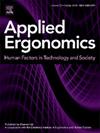VR- or lecture-based training? The role of culture in safety training outcomes
IF 3.4
2区 工程技术
Q2 ENGINEERING, INDUSTRIAL
引用次数: 0
Abstract
Virtual reality (VR) training provides immersive, risk-free experiences that leverage multisensory integration to improve memory retention, presence and embodiment to strengthen engagement and attention, and situational learning to promote transfer of training to real-world contexts. Adding gamification through serious games (SG) further enhances engagement and active learning. This study validates a VR-SG safety training previously evaluated in Colombia, now applied to 74 professional roofers in Germany comparing ViStra (VR-SG) with LeStra (lecture-based with problem-based learning). Using Kirkpatrick's model, we assessed reaction, cognitive and attitudinal outcomes, self-reported behavior, and safety climate through validated questionnaires. Both programs improved cognitive and attitudinal outcomes, with no significant differences. No effects were found for behavior or safety climate. Thus, ViStra matched LeStra's effectiveness. Post hoc comparison with Colombian data suggests cultural factors influence some outcomes, highlighting the importance of adapting training strategies to cultural contexts for future safety training strategies in diverse work environments.
基于VR还是基于讲座的培训?文化在安全培训结果中的作用
虚拟现实(VR)培训提供身临其境、无风险的体验,利用多感官整合来提高记忆保留、存在感和体现力,加强参与和注意力,以及情景学习,促进培训转移到现实环境中。通过严肃游戏(SG)加入游戏化,进一步提高参与度和主动学习。这项研究验证了之前在哥伦比亚评估的VR-SG安全培训,现在应用于德国的74名专业屋顶工人,比较了ViStra (VR-SG)和LeStra(基于讲座和基于问题的学习)。采用Kirkpatrick的模型,我们通过验证问卷评估反应、认知和态度结果、自我报告行为和安全气候。两种方案都改善了认知和态度结果,没有显著差异。没有发现对行为或安全气候的影响。因此,瑞致达达到了乐致达的效果。与哥伦比亚数据的事后比较表明,文化因素影响了一些结果,突出了使培训战略适应文化背景的重要性,以便在不同的工作环境中制定未来的安全培训战略。
本文章由计算机程序翻译,如有差异,请以英文原文为准。
求助全文
约1分钟内获得全文
求助全文
来源期刊

Applied Ergonomics
工程技术-工程:工业
CiteScore
7.50
自引率
9.40%
发文量
248
审稿时长
53 days
期刊介绍:
Applied Ergonomics is aimed at ergonomists and all those interested in applying ergonomics/human factors in the design, planning and management of technical and social systems at work or leisure. Readership is truly international with subscribers in over 50 countries. Professionals for whom Applied Ergonomics is of interest include: ergonomists, designers, industrial engineers, health and safety specialists, systems engineers, design engineers, organizational psychologists, occupational health specialists and human-computer interaction specialists.
 求助内容:
求助内容: 应助结果提醒方式:
应助结果提醒方式:


